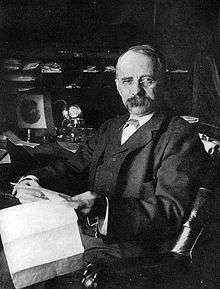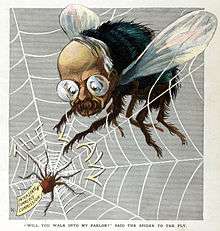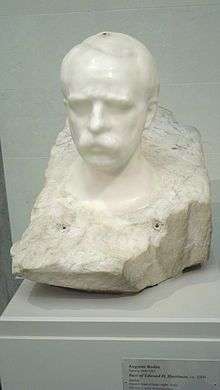E. H. Harriman
| E. H. Harriman | |
|---|---|
 | |
| Born |
Edward Henry Harriman February 20, 1848 Hempstead, New York, US |
| Died |
September 9, 1909 (aged 61) Orange County, New York, US |
| Resting place | St. John's Church Cemetery, Arden, New York |
| Occupation | Railroad executive |
| Known for | Harriman Alaska Expedition |
| Spouse(s) | Mary Williamson Averell |
| Children |
Mary Harriman Rumsey Henry Neilson Harriman Cornelia Harriman Gerry[1] Carol A. Harriman William Averell Harriman Edward Roland Noel Harriman |
| Relatives | Herbert M. Harriman (cousin) |
Edward Henry "Ned" Harriman (February 20, 1848 – September 9, 1909) was an American railroad executive.[2][3][4]
Early life
Harriman was born on February 20, 1848 in Hempstead, New York, the son of Orlando Harriman, Sr., an Episcopal clergyman, and Cornelia Neilson.[3] He had a brother, Orlando Harriman, Jr.[5] His great-grandfather, William Harriman, emigrated from England in 1795 and engaged successfully in trading and commercial pursuits.
As a young boy, Harriman spent a summer working at the Greenwood Iron Furnace in the area owned by the Robert Parker Parrott family that would become Harriman State Park. He quit school at age 14 to take a job as an errand boy on Wall Street in New York City. His uncle Oliver Harriman had earlier established a career there. By age 22, he was a member of the New York Stock Exchange.
Career
Harriman's father-in-law was president of the Ogdensburg and Lake Champlain Railroad Company, which aroused Harriman's interest in upstate New York transportation. In 1881, Harriman acquired the small, broken-down Lake Ontario Southern Railroad. He renamed it the Sodus Bay & Southern, reorganized it, and sold it to the Pennsylvania Railroad at a considerable profit. This was the start of his career as a rebuilder of bankrupt railroads.

Harriman was nearly 50 years old when in 1897 he became a director of the Union Pacific Railroad. By May 1898, he was chairman of the executive committee, and from that time until his death his word was law on the Union Pacific system. In 1903, he assumed the office of president of the company. From 1901 to 1909, Harriman was also the President of the Southern Pacific Railroad. The vision of a unified UP/SP railroad was planted with Harriman. (The UP and SP were reunited on September 11, 1996, a month after the Surface Transportation Board had approved their merger.)
At the time of his death Harriman controlled the Union Pacific, the Southern Pacific, the Saint Joseph and Grand Island, the Illinois Central, the Central of Georgia, the Pacific Mail Steamship Company, and the Wells Fargo Express Company. Estimates of his estate ranged from $150 million to $200 million. It was left entirely to his wife.
The Harriman Alaska Expedition
In 1899, Harriman sponsored and accompanied a scientific expedition to catalog the flora and fauna of the Alaska coastline. Many prominent scientists and naturalists went on the expedition, aboard the luxuriously refitted 250-foot (76 m) steamer George W. Elder.[6]
Interest in ju-jitsu
Harriman became interested in ju-jitsu after his two-month visit to Japan in 1905.[7] When he returned to America, he brought with him a troupe of six Japanese ju-jitsu wrestlers, including the prominent judokas Tsunejiro Tomita and Mitsuyo Maeda.[8] Among many performances, the troupe gave an exhibition that drew six hundred spectators in the Columbia University gymnasium on February 7, 1905.[9]
Personal life
In 1879, Harriman married Mary Williamson Averell, daughter of William J. Averell, a banker in Ogdensburg, New York.[10] Together they had:
- Mary Harriman (1881-1934), who married Charles Cary Rumsey (1879–1922), a sculptor
- Henry Neilson Harriman (b. 1883)
- Cornelia Harriman Gerry (1884-1966),[1] who married Robert Livingston Gerry, Sr. (1877–1957)
- Carol A. Harriman (b. 1889)
- William Averell Harriman (1891-1986), the Secretary of Commerce under President Harry S. Truman, the 48th Governor of New York, the U.S. Ambassador to the Soviet Union and U.S. Ambassador to Britain. He was married three times: First to Kitty Lanier Lawrance (from 1915 until their divorce in 1929), then Marie Norton Whitney (from 1930 until her death in 1970), then lastly Pamela Beryl Digby Churchill Hayward (from 1971 until his death in 1986)[11]
- Edward Roland Noel Harriman (1895-1978), who married Gladys Fries (1896-1983)
Harriman died on September 9, 1909 at his home, Arden, at 1:30 p.m. at age 61.[2][3] Naturalist John Muir, who had joined him on the 1899 Alaska Expedition, wrote in his eulogy of Harriman, "In almost every way, he was a man to admire." Harriman was buried at the St. John's Episcopal Church cemetery in the hamlet of Arden, near his estate.[12]
Harriman estate
In 1885, Harriman acquired "Arden", the 7,863-acre (31.82 km2) Parrott family estate in the Ramapo Highlands near Tuxedo, New York, for $52,500. Over the next several years he purchased almost 40 different nearby parcels of land, adding 20,000 acres (81 km2), and connected all of them with 40 miles (64 km) of bridle paths. His 100,000 sq ft (9,300 m2) residence, Arden House, was completed only seven months before he died.
In the early 1900s, his sons W. Averell Harriman and E. Roland Harriman hired landscape architect Arthur P. Kroll to landscape many acres. In 1910, his widow donated 10,000 acres (40 km2) to the state of New York for Harriman State Park. The estate was designated a National Historic Landmark in 1966.
Legacy

Award
- In 1913, his widow created the E. H. Harriman Award to recognize outstanding achievements in railway safety. The award has been presented on an annual basis since then.
Namesakes
- The Union Pacific Harriman Dispatch Center in Omaha, Nebraska is named for Edward H. Harriman.
- Harriman Glacier in Alaska's Chugach National Forest, located in Whittier, Alaska, was named for him by the Harriman Alaska Expedition
- Two post offices in Oregon were named for Harriman, including the one at Rocky Point, where he maintained a summer camp for several years.[13]
- Financial and business publisher Harriman House is named after Harriman.
- The city of Sparks, Nevada was known as Harriman during its early existence.
Places built using funds donated from his sponsorship or estate
- Harriman founded the Tompkins Square Boys’ Club, now known as The Boys’ Club of New York. The original club, founded in 1876, was located in the rented basement of the Wilson School in Manhattan’s Lower East Side, and began with three boys.[14] Harriman’s idea for the club was to provide a place "for the boys, so as to get them off the streets and teach them better manners."[15] By 1901, the club had outgrown its space. Harriman purchased several lots on 10th and Avenue A, and a five-story clubhouse was completed in 1901.[16]
- Inheritance taxes from Harriman's estate, in the amount of $798,546 paid by his widow on March 1, 1911 to the State of Utah, helped fund the construction of the state's capitol.
- Harriman State Park in Tuxedo, NY
Notable quotations
"Much good work is lost for the lack of a little more."
"Cooperation means 'Do as I say, and do it damn quick.'" [17]
In popular culture
- Harriman is mentioned in the movie Butch Cassidy and the Sundance Kid (1969), as the commercial baron whose agents become the title characters' nemeses. In the film's second train robbery, a railroad employee ascribes his refusal to cooperate with the robbery to his obligations to Harriman personally, and one of Butch and Sundance's intimates describes Harriman's hiring of famed outlaw-hunters to track down the gang's leaders.
- In the movie The Wild Bunch (1969), a railroad official named "Harrigan" takes the same strategy.
See also
References
- 1 2 "Mrs. Robert L. Gerry Dies at 82. Last Daughter of E.H. Harriman". New York Times. May 30, 1966. Retrieved 2012-11-22.
Mrs. Cornelia Harriman Gerry, widow of Robert L. Gerry, financier and sportsman, died yesterday, at her home at 79 East 79th Street. She was 82 years old. ...
- 1 2 "Harriman Dead. News Delayed. Financier's End Came at 1:30 o'clock, with His Family About His Bedside. The Official Announcement Had Set the Hour of Death Some Two Hours Later. Cancer or Tuberculosis of the Bowels Each Said to be the Cause. Universal Tributes to His Genius and Indomitable Courage. The Financial World Not Taken Unaware". New York Times. September 9, 1909. Retrieved 2015-02-04.
Edward H. Harriman died at Arden House this afternoon at 1:30 o'clock. The news of his death was withheld for two hours, when official announcement was made that the financier had passed away at 3:35 o'clock.
- 1 2 3 "Edward H. Harriman". PBS. Retrieved 2012-11-22.
Edward Henry Harriman was born in New Jersey [sic] in 1848. His father was an ordained deacon in the Presbyterian Church, his mother a well-connected socialite from New Jersey. ...
- ↑ Kennan, George (1922). E. H. Harriman: A Biography in Two Volumes. 1. Boston: Houghton Mifflin Company, The Riverside Press Cambridge. pp. 95, 132.
- ↑ "Orlando Harriman Dead. Brother of E.H. Harriman and Big Realty Operator". New York Times. December 30, 1911. Retrieved 2012-11-22.
Orlando Harriman, brother or the late EH Harriman, died early yesterday in Dr. John Walker's Sanitarium, 33 East Thirty-third Street, from a complication of ...
- ↑ "E.H. Harriman: Harriman Expedition Retraced". PBS.
- ↑ "HARRIMAN TO VISIT JAPAN.; He Will Take His Family and Be Away Several Months." (PDF). The New York Times. June 28, 1905. Retrieved September 5, 2010.
- ↑ "JU-JITSU AS IN JAPAN.; E.H. Harriman's Troupe of Six Clever Wrestlers and Swordsmen.". The New York Times. February 4, 1906. Retrieved September 5, 2010.
- ↑ "JUDO FOR SELF-DEFENCE". New-York Daily Tribune. Washington, DC. Library of Congress. February 8, 1906. p. 5. Retrieved September 5, 2010.
- ↑ "Mrs. E.H. Harriman Dies at Age of 81. Widow of Railroad Financier, Who Left to Her His Entire Estate of $100,000,000. Noted For Philanthropies. Aided Red Cross and Artistic and Educational Causes. Interested In Rail Workers' Welfare". New York Times. November 8, 1932. Retrieved 2012-11-22.
- ↑ "Mrs. W. Averell Harriman Dies; Former Governor's Wife Was 67". New York Times. September 27, 1970. Retrieved February 17, 2015.
- ↑ "Edward Henry Harriman". Find a Grave.
- ↑ McArthur, Lewis A.; McArthur, Lewis L. (2003) [1928]. Oregon Geographic Names (7th ed.). Portland, Oregon: Oregon Historical Society Press. pp. 448, 567, 820. ISBN 978-0875952772.
- ↑ "BCNY History". Boys' Club of New York. Retrieved March 7, 2012.
- ↑ Kennan, p. 26
- ↑ Kennan, p. 39
- ↑ attributed to Harriman by Delos F. Wilcox in "Co-operation Between State and Local Authorities in the Control of Public Utilities", Minnesota Municipalities Vol V Number 1, February 1920, page 12
Further reading
- Haeg, Larry, Harriman vs Hill: Wall Street's Great Railroad War, University of Minnesota Press, 2013
- Kahn, Otto H., Edward Henry Harriman (1911), reprinted as "The Last Figure of an Epoch: Edward Henry Harriman," in Our Economic and Other Problems (1920)
- Klein, Maury. The Life & Legend of EH Harriman. Univ of North Carolina Press (2000), The standard scholarly biography online
- Kennan, George (1917). The Salton Sea: An Account of Harriman's Fight With The Colorado River. New York: The MacMillan Company. Retrieved 2009-07-11.
- Kennan, George (1917). E. H. Harriman's Far Eastern Plans. Boston: The Country Life Press. Retrieved 2009-07-11.
- Kennan, George (1922). E. H. Harriman: A Biography, Vols I and II. Boston: Houghton Mifflin. External link in
|title=(help) - Keys, C.M. (January 1907). "Harriman I: The Man In The Making, His Early Life and Start". The World's Work: A History of Our Time. XIII: 8455–8464. Retrieved 2009-07-10.
- Keys, C.M. (February 1907). "Harriman II: The Building of His Empire". The World's Work: A History of Our Time. XIII: 8537–8552. Retrieved 2009-07-10.
- Keys, C.M. (March 1907). "Harriman III: The Spinner of Golden Webs". The World's Work: A History of Our Time. XIII: 8651–8664. Retrieved 2009-07-10.
- Keys, C.M. (March 1907). "Harriman IV: Salvage of the Two Pacifics". The World's Work: A History of Our Time. XIII: 8791–8803. Retrieved 2009-07-10.
- Meyer, Balthazar Henry (July 1906). "A History of the Northern Securities Case". Bulletin of the University of Wisconsin. 142. Retrieved 2009-07-10. Also see Northern Securities Co. v. United States.
- Muir, John, Edward Henry Harriman (1911)
- Myles, William J., Harriman Trails, A Guide and History, The New York-New Jersey Trail Conference, New York, N.Y., 1999
- Ripley, William Zebina (1915). Railroads: Finance and Organization. New York: Longmans, Green, and Co. Retrieved 2009-07-11.
- "In the Matter of Consolidations and Combinations of Carriers," Interstate Commerce Commission Reports, XII (1908)
- Articles and estimates of his life and work in Cosmopolitan, Mar. 1903, July 1909; Moody's Mag., Oct. 1906, Oct. 1909; Am. Rev. of Revs., Jan. 1907, Oct. 1909; McClure's Mag., Oct. 1909, Jan. 1911; N. Y. Times and N. Y. Sun, September 10, 1909; Railway World, September 17, 1909.
External links
| Wikimedia Commons has media related to Edward Henry Harriman. |
- University of Washington Libraries Digital Collections – Harriman Alaska Expedition of 1899 254 photographs from 1899 of Edward Harriman's scientific expedition to Alaska, including images of Alaskan Native Americans and their villages, scenic views of the coastline, glaciers and Alaskan towns.